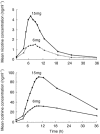An oral formulation of nicotine for release and absorption in the colon: its development and pharmacokinetics
- PMID: 10583017
- PMCID: PMC2014372
- DOI: 10.1046/j.1365-2125.1999.00057.x
An oral formulation of nicotine for release and absorption in the colon: its development and pharmacokinetics
Abstract
Aims: Ulcerative colitis is predominantly a disease of nonsmokers and transdermal nicotine has therapeutic value in active disease; however side-effects are troublesome. The aim of this study was to develop an oral formulation of nicotine which would be slowly released in the colon over 6 h, and to examine its pharmacokinetic profile in 12 healthy volunteers, with measurements of serum nicotine and cotinine, its principal metabolite.
Methods: Nicotine was combined with a polyacrylic carbomer, Carbopol 974P which was incorporated into 13 different vehicles and their release profiles examined in vitro. The polyglycolized glyceride, Gelucire 50/13, was chosen for subsequent kinetic studies because it consistently produced a suitable release pattern which was linear. Capsules containing 3 mg nicotine, combined with carbomer in Gelucire 50/13, were coated with an acrylic resin Eudragit L; this ensured the capsule would remain intact until the ileum. On 2 separate days, 6 and 15 mg nicotine, contained in 2 and 5 capsules, respectively, were administered to 12 subjects, all nonsmokers, mean age 28 years. Serial blood measurements were taken for 36 h, serum nicotine and cotinine concentrations were measured by gas liquid chromatography.
Results: There was considerable intersubject variability in the nicotine and cotinine values. Plasma nicotine levels began to rise about 4 h after ingestion of the capsules, corresponding with the oro-caecal transit time. Cmax nicotine values were 2.2 and 5 ng ml-1, obtained 7 h after the ingestion of 6 and 15 mg, respectively, of the formulation. The corresponding Cmax values for cotinine were 37 and 94.4 ng ml-1, occurring after 9-10 h. The mean for elimination half-lives in the 24 studies, including the 6 and 15 mg doses, for nicotine were 4.3+/-2.7 h and for cotinine 16.8+/-7.5 h. With 6 mg nicotine-carbomer, only 1 of 12 volunteers had possible side-effects, but with the 15 mg dose 11 out of the 12 reported adverse effects which were systemic or gastrointestinal in nature-their timing corresponded with peak serum concentrations of nicotine.
Conclusions: An oral formulation of nicotine has been developed; in the ileum and colon, this becomes available for slow linear release over 6 h and delivers high concentrations of nicotine for topical effect on the colon. 6 mg Nicotine was well tolerated, whilst 15 mg gave both systemic and gastrointestinal side-effects. High concentrations of topical nicotine in the colon are achieved with relatively low systemic bioavailablity-reflected by the Cmax and AUC values for nicotine. This, or comparable formulations, may be of therapeutic value in ulcerative colitis.
Figures




Similar articles
-
Pharmacokinetics of nicotine carbomer enemas: a new treatment modality for ulcerative colitis.Clin Pharmacol Ther. 1997 Mar;61(3):340-8. doi: 10.1016/S0009-9236(97)90167-3. Clin Pharmacol Ther. 1997. PMID: 9084459
-
Nicotine carbomer enemas--pharmacokinetics of a revised formulation.Ital J Gastroenterol Hepatol. 1998 Jun;30(3):260-5. Ital J Gastroenterol Hepatol. 1998. PMID: 9759592 Clinical Trial.
-
A dose-ranging pharmacokinetic study of nicotine tartrate following single-dose delayed-release oral and intravenous administration.Aliment Pharmacol Ther. 1997 Oct;11(5):865-74. doi: 10.1046/j.1365-2036.1997.00236.x. Aliment Pharmacol Ther. 1997. PMID: 9354194
-
Pharmacology of nicotine: addiction and therapeutics.Annu Rev Pharmacol Toxicol. 1996;36:597-613. doi: 10.1146/annurev.pa.36.040196.003121. Annu Rev Pharmacol Toxicol. 1996. PMID: 8725403 Review.
-
Nicotine treatment for ulcerative colitis.Br J Clin Pharmacol. 1999 Oct;48(4):481-4. doi: 10.1046/j.1365-2125.1999.00039.x. Br J Clin Pharmacol. 1999. PMID: 10583016 Free PMC article. Review. No abstract available.
Cited by
-
Role of smoking in inflammatory bowel disease: implications for therapy.Postgrad Med J. 2000 May;76(895):273-9. doi: 10.1136/pmj.76.895.273. Postgrad Med J. 2000. PMID: 10775279 Free PMC article. Review.
-
Smoking-Related Gene Expression in Laser Capture-Microdissected Human Lung.Clin Cancer Res. 2009 Dec 15;15(24):7562-7570. doi: 10.1158/1078-0432.CCR-09-1694. Clin Cancer Res. 2009. PMID: 19996203 Free PMC article.
References
-
- Jick H, Walker AM. Cigarette smoking and ulcerative colitis. N Engl J Med. 1983;308:261–263. - PubMed
-
- Boyko EJ, Koepsell TD, Perera DR, Inui TS. Risk of ulcerative colitis among former and current cigarette smokers. N Engl J Med. 1987;316:707–710. - PubMed
-
- Calkins BM. A meta-analysis of the role of smoking in inflammatory bowel disease. Dig Dis Sci. 1989;34:1841–1854. - PubMed
Publication types
MeSH terms
Substances
LinkOut - more resources
Full Text Sources
Other Literature Sources
Medical

